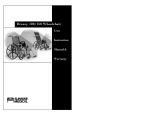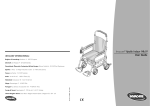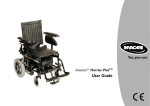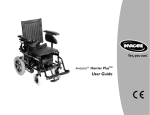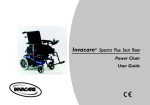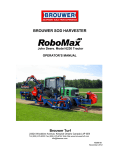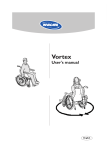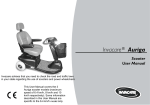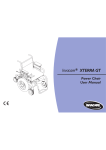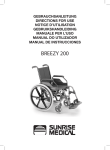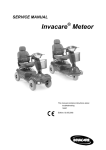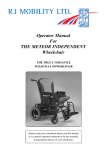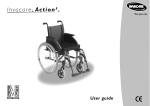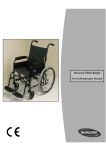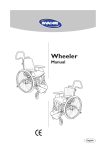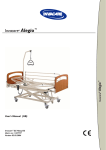Download Harrier XHD UM 0303
Transcript
1433150 - 0403 GB Harrier XHD UG Cover.qxd 24/03/2003 Front cover image/photo to be provided 13:56 Page 1 Invacare R Harrier XHD User Manual 2 Harrier XHD UM 0303-1.p65 ISO 7176-15: 1996 Requirements for Information Disclosure, Documentation and Labelling 2 Manufacturer: Invacare Limited Address: South Road, Bridgend Industrial Estate, Bridgend. CF31 3PY Model Designation: HARRIER Extra Heavy Duty 18in, 20in and 22in Models Maximum Occupant Mass (Weight): 160kgs (25 Stone) 3/24/2003, 1:41 PM ISO Test Method Requirement 1210mm ISO 7176 Pt 7 Seat Plane Angle 3 deg 3 deg 760mm (ii) ISO 7176 Pt 7 Effective Seat Depth 490mm 525mm 825mm 825mm ISO 7176 Pt 7 Effective Seat Width 435mm (i) 575mm (ii) Folded Width 405mm 405mm ISO 7176 Pt 7 Seat Surface Height at Front Edge 575mm 575mm Folded Height 745mm 745mm ISO 7176 Pt 7 Backrest Angle 12deg 24deg 88kg 91kg ISO 7176 Pt 7 Backrest Height 440mm 440mm 35kg chassis ISO 7176 Pt 7 Footrest to Seat Distance 420mm 510mm 24.5 deg 28 deg ISO 7176 Pt 7 Leg to Seat Surface Angle 111deg 111deg 20 deg 24.5 deg ISO 7176 Pt 7 Armrest to Seat Distance 180mm 260mm 18.5km 18.5km ISO 7176 Pt 7 Front Location of Armrest Structure (Front Armrest to Backrest) 445mm 480mm 10 deg 10 deg ISO 7176 Pt 7 Handrim Diameter N/A N/A 65mm 100mm ISO 7176 Pt 7 Horizontal Location of Axle 80mm 115mm Maximum Speed Forward 6.4km/h 6.4km/h ISO 7176 Pt 5 Minimum Turning Radius 970mm Minimum Braking Distance from Maximum Speed 1008 mm 1008 mm ISO 7176 Pt 5 Turn Around Width Between Limiting Walls 1320mm ISO Test Method Requirement ISO 7176 Pt 5 ISO 7176 Pt 5 Min. Max. Overall Length with Legrest 1130mm Overall Width 660mm (i) ISO 7176 Pt 5 Folded Length ISO 7176 Pt 5 ISO 7176 Pt 5 ISO 7176 Pt 5 Total Mass (Weight) C.E.N. Mass (Weight) of the Heaviest Part ISO 7176 Pt 1 Static Stability Downhill ISO 7176 Pt 1 Static Stability Sideways ISO 7176 Pt 4 Energy Consumption (Range) ISO 7176 Pt 2 Dynamic Stability Uphill ISO 7176 Pt 10 Obstacle Climbing ISO 7176 Pt 6 ISO 7176 Pt 3 (i) 18in wide model (min) Min. (ii) 22in wide model (max) The Wheelchair conforms to the following standards: ISO 7176 Pt 8 Static, Impact and Fatigue Strength PASS ISO 7176 Pt 9 Climatic Tests PASS ISO 7176 Pt 14 power and Controls PASS ISO 7176 Pt 16 Resistance to Ignition PASS Max. Warranty Terms & Conditions Standard INVACARE terms This is to certify that your HARRIER XHD power chair is warranted by INVACARE Ltd., for a period of 1 year. 1. Only INVACARE chairs purchased at full price are warranted against defective workmanship and materials. 2. If a defect or fault is discovered the INVACARE dealer from whom the appliance was obtained should be notified immediately. 3. The manufacturer will not accept responsibility for damage caused by misuse or non-observance of the instructions set out in the users manual. 4. During the period of the Warranty, any parts that have become defective due to faulty workmanship or materials, will be renewed or repaired without charge by the INVACARE dealer. 5. The Warranty will be forfeited should any unauthorised alteration be made to the equipment. 6. The Purchaser’s statutory rights under the Consumer Protection Act are not affected. 3 Harrier XHD UM 0303-1.p65 3 3/24/2003, 1:41 PM Limitation of liability This Warranty does not extend to the consequential costs resulting from fault clearance, in particular freight and travel costs, loss of earnings, expenses etc. • natural wear and tear • inappropriate or incorrect use • defective assembly or setting-up by the purchaser or third parties • defective or neglectful treatment • use of unsuitable spares 4 Harrier XHD UM 0303-1.p65 4 3/24/2003, 1:41 PM Contacting For questions or support, please contact your authorised INVACARE Dealer. He has the necessary know-how and equipment plus the special knowledge concerning your wheelchair which enables him to offer you all-round satisfactory service. Should you wish to contact us directly, we are at your service under the following addresses and phone numbers. United Kingdom INVACARE Ltd. South Road Bridgend Mid Glamorgan - CF31-3PY Tel (Customer Service): 01656 - 647 327 Fax (Customer Service): 01656 - 649 016 France INVACARE POIRIER S.A. Les Roches F-37230 Fondettes Tel (Service Après-Vente): 02 47 - 62 64 15 Fax (Service Après-Vente): 02 47 - 62 64 64 Deutschland INVACARE Deutschland GmbH Dehmer Str. 66 D-32549 Bad Oeynhausen Tel (Kundendienst): 05731 - 754 210 Fax (Kundendienst): 05731 - 754 216 5 Harrier XHD UM 0303-1.p65 5 3/24/2003, 1:41 PM The Netherlands INVACARE BV Celsiusstraat 46 NL-6716 BZ Ede Tel : +31 - (0) 318 - 550 056 Fax: +31 - (0) 318 - 555 054 Sverige INVACARE AB Phone or Fax INVACARE Ltd for current address. Spain INVACARE SA c/Areny, s/n, Poligon Industrial de celrà, 17460 Celrà (girona) - España Tel. 0972 - 49 32 00 Fax: 0972 - 49 32 20 Italy Mecc San S.R.L. Via Dei Pini, 35 I - 36016 Thiene (VI) - Italia Tel: 0445 - 380059 Fax: 0445 - 380034 Portugal INVACARE PORTUGAL Lda Rua Senhora de Campanhâ, 105 4369-001 Porto - Portugal Tel. 02 - 510 57 39 Fax: 02 - 510 50 20 6 Harrier XHD UM 0303-1.p65 6 3/24/2003, 1:41 PM Contents ISO 7176-15: 1996 Requirements for Information Disclosure, Documentation and Labelling ............................................................................................................ 2 Warranty Terms & Conditions .......................................................................................... 3 Standard INVACARE terms ......................................................................................................... 3 Limitation of liability ..................................................................................................................... 4 Contacting.......................................................................................................................... 5 1 Introduction..................................................................................................... 10 1.1 1.2 2 Important symbols in this manual .................................................................................... 12 Type classification and area of use .................................................................................. 13 Safety Notes .................................................................................................... 14 2.1 2.2 2.3 2.4 3 4 Repair or service information .......................................................................................... General safety notes ....................................................................................................... Safety information on electromagnetic interference ......................................................... Safety precautions/safe operation ................................................................................... 14 14 17 18 Some Useful Tips ............................................................................................ 21 Safety Inspection Checklist ........................................................................... 26 4.1 4.2 4.3 4.4 Troubleshooting - mechanical ......................................................................................... Troubleshooting - electrical .............................................................................................. Checking battery charge level ......................................................................................... Care and maintenance .................................................................................................... 29 30 32 33 7 Harrier XHD UM 0303-1.p65 7 3/24/2003, 1:41 PM 5 6 7 Detachable/Ajustable Backrest ..................................................................... 34 Armrest Adjustment ....................................................................................... 37 Controls and Operating your Power Chair ................................................... 38 8.1 8 9 10 Operation ........................................................................................................................ 38 Footrests ......................................................................................................... 40 PUSHING THE CHAIR .................................................................................... 42 Operating your Powerchair Outdoors .......................................................... 43 11.1 Kerb Climbing - Centre Mounting .................................................................................... 43 11.2 Going up a Kerb .............................................................................................................. 44 11.3 Going down a Kerb ......................................................................................................... 44 11 12 Drive Wheel Locks ......................................................................................... 45 Transporting your chair ................................................................................. 46 13.1 Firm Seat and Back ........................................................................................................ 46 13.2 Transportation of Wheelchairs in Vehicles ..................................................................... 49 13 14 Lateral Support ............................................................................................... 53 Charging Batteries ......................................................................................... 55 16.1 Batteries .......................................................................................................................... 55 15 16 Keeping Your Chair in Good Condition ........................................................ 58 Fault Finding ................................................................................................... 61 8 Harrier XHD UM 0303-1.p65 8 3/24/2003, 1:41 PM 1 Introduction Dear User First of all we wish to thank you for your confidence in our products! We hope you will enjoy your new power chair. This manual contains important hints and information on Harrier XHD Power Chair: Familiarise yourself thoroughly before making your first trip. The information contained in this document is subject to change without notice. As a manufacturer of wheelchairs, Invacare endeavours to supply a wide variety of wheelchairs to meet many needs of the end user. However, final selection of the type of wheelchair to be used by an individual rests solely with the user and his/her healthcare professional capable of making such a selection. Do not operate this equipment without first reading and understanding this manual. If you are unable to understand the warnings, cautions, and instructions, contact your dealer otherwise injury or damage may result. The initial set up of this wheelchair must be performed by a qualified technician. Procedures other than those described in this manual must be performed by a qualified technician. NOTE: Not all of the components within this manual will necessarily be available with your HARRIER XHD power wheelchair. This manual is a multinational operator’s manual and any references not applicable to your product should be ignored. 9 Harrier XHD UM 0303-1.p65 9 3/24/2003, 1:41 PM 1.1 Important symbols in this manual WARNING: THIS SYMBOL WARNS YOU OF DANGER! • Follow the instructions to avoid injury to the user or damage to the product! NOTE: This symbol indicates hints and suggestions which should help make operating the product easier and point out special functions. Requirements: • This symbol indicates a list of the different tools and other requirements you will need to do certain maintenance work. 10 Harrier XHD UM 0303-1.p65 10 3/24/2003, 1:41 PM 1.2 Type classification and area of use The HARRIER XHD is a Class 2 vehicle with a maximum speed of 4mph (6.4km/h) for use only on pavements, footpaths, pedestrian zones and areas free from motor traffic. It is not allowed on the highway except for the purpose of crossing. WARNING: • Under no circumstances must the top speed of the Class 2 HARRIER XHD be increased, to do so will infringe Road Traffic Act Regulations. 11 Harrier XHD UM 0303-1.p65 11 3/24/2003, 1:41 PM 2 Safety Notes 2.1 Repair or service information Setup of the Electronic Control Unit is to be performed ONLY by individuals certified by Invacare. The final tuning adjustments of the controller may affect other activities of the wheelchair. Damage to the equipment could occur under these circumstances. If non-certified individuals perform any work on these units, the warranty is void. 2.2 General safety notes GENERAL WARNINGS • Performance adjustments should only be made by professionals of the healthcare field or persons fully conversant with this process and the driver's capabilities. Incorrect settings could cause injury to the driver, bystanders, damage to the chair and to surrounding property. • After the wheelchair has been setup, check to make sure that the wheelchair performs to the specifications entered during the setup procedure. If the wheelchair does NOT perform to specifications, turn the wheelchair OFF immediately and re-enter setup specifications. Repeat this procedure until the wheelchair performs to specifications. • DO NOT climb, go up or down ramps or traverse slopes greater than 9°. • DO NOT attempt to move up or down an incline with a water, ice or oil film. • DO NOT attempt to drive over curbs or obstacles greater than 50mm (2in) in height. Doing so may cause your wheelchair to turn over and cause bodily harm or damage to the chair. 12 Harrier XHD UM 0303-1.p65 12 3/24/2003, 1:41 PM • Always stop before climbing an obstacle. Approach slowly until castors contact the obstacle. Weight is transferred to the drive wheels providing traction and motor strength to power the chair over the obstacle. • DO NOT use parts, accessories, or adapters other than those authorized by Invacare. • DO NOT stand on the frame of the wheelchair. TYRE PRESSURE • DO NOT use your wheelchair unless it has the proper tyre pressure (P.S.I.). DO NOT overinflate the tyres. Failure to follow these suggestions may cause the tyre to explode and cause bodily harm. The recommended tyre pressure is listed on the side wall of the tyre. BATTERIES • The warranty and performance specifications contained in this manual are based on the use of deep cycle gel cell batteries. Invacare strongly recommends their use as the power source for this unit. • Carefully read battery/battery charger information prior to installing, servicing or operating your wheelchair. ELECTRICAL • Extreme care should be exercised when using oxygen in close proximity to electrical circuits. Contact your oxygen supplier for instructions in the safe use of oxygen. 13 Harrier XHD UM 0303-1.p65 13 3/24/2003, 1:41 PM RAIN TEST • INVACARE has tested its power wheelchairs in accordance with ISO 7176 Part 9 “Rain Test”. This provides the end user or his/her attendant sufficient time to remove his/her power wheelchair from a rain storm and retain wheelchair operation. • DO NOT leave power wheelchair in a rain storm of any kind. • DO NOT use power wheelchair in a shower or leave it in a damp bathroom while taking a shower. • DO NOT leave power wheelchair in a damp area for any length of time. • Direct exposure to rain or dampness will cause the chair to malfunction electrically and mechanically and may cause the chair to rust prematurely. • Check to ensure that the battery covers are secured in place. • DO NOT use the joystick if the boot is torn or cracked. If the joystick boot becomes torn or cracked, replace IMMEDIATELY. WEIGHT TRAINING • Invacare DOES NOT recommend the use of its wheelchairs as a weight training apparatus. Invacare wheelchairs have NOT been designed or tested as a seat for any kind of weight training. If occupant uses said wheelchair as a weight training apparatus, Invacare shall NOT be liable for bodily injury and the warranty is void. WEIGHT LIMITATION • The HARRIER XHD has a maximum user weight limitation of 114kg (18stone). 14 Harrier XHD UM 0303-1.p65 14 3/24/2003, 1:41 PM 2.3 Safety information on electromagnetic interference This electric vehicle was successfully tested in accordance with international standards as to its compliance with Electromagnetic Interference (EMI) regulations. However, electromagnetic fields, such as those generated by radio and television transmitters, and cellular phones, can influence the functions of electric vehicles. Also, the electronics used in our vehicles can generate a low level of electromagnetic interference, which however will remain within the tolerances permitted by law. For these reasons we ask you to please observe the following precautions: WARNING: DANGER OF MALFUNCTION DUE TO ELECTROMAGNETIC INTERFERENCE! • Do not switch on or operate portable transceivers or communication devices (such as radio transceivers or cellular phones) when the vehicle is switched on! • Avoid getting near strong radio and television transmitters! • In case the vehicle should be set in motion unintentionally or the brakes are released, switch it off immediately! • Adding electrical accessories and other components or modifying the vehicle in any way can make it susceptible to electromagnetic interference. Keep in mind that there is no sure way to determine the effect such modifications will have on the overall immunity of the electronic system! • Report all occurrences of unintentional movement of the vehicle, or release of the electronic brakes to the manufacturer! 15 Harrier XHD UM 0303-1.p65 15 3/24/2003, 1:41 PM 2.4 Safety precautions/safe operation IMPORTANT WARNING • The day-to-day activities and the more advanced power chair techniques depend, on your physical capabilities and your own specific circumstances. Our recommendations may occasionally differ from those of your Therapeutic Adviser or Physician, as they have a better understanding of your abilities. Where this is the case, you MUST FOLLOW THEIR advice, they are better placed to tell you what is suitable for you and what is not. • DO NOT use your power chair when your driving ability is impaired by medication or alcohol. CAUTION • Avoid using your power chair on rough ground or in adverse weather conditions (snow or ice), always steer clear of obstacles where possible, ensure your clothing and hands are kept clear of all moving parts, ask for assistance when descending or ascending steep gradients. Never attempt to negotiate stairs. Never use an escalator to move a power chair between floors. Due to both the weight of a power chair and its occupant it is not advisable to attempt to be assisted up and down stairs whilst the power chair is occupied. • If you are a user with limited mobility we advise that in the case of adverse weather conditions i.e. extreme cold, DO NOT attempt a journey without an accompanying attendant. In the event of a power failure you could become stranded in an isolated area, where there is the strong possibility you will be unable to get immediate assistance. • Braking of your power chair is dependent on electromagnetic motor brakes. When these are disengaged by declutching the motor gear box drive system, the chair is in freewheel mode, this mode is for emergency use only and motor gear boxes should remain engaged at all other times. • To avoid the power chair freewheeling, special care must be taken to engage motor brakes. 16 Harrier XHD UM 0303-1.p65 16 3/24/2003, 1:41 PM SAFETY INDOORS • When using your power chair indoors always consider the following potential hazards: • Beware of the fact that many of the premises where you are likely to use your power chair may not have been designed with this consideration in mind. You should therefore have an awareness for safety when encountering the likes of narrow doorways, steps, high surfaces, protruding wall fittings and every day household items such as children’s toys, electrical appliances etc. Take extra care in kitchen environments. • Consider the fire evacuation procedures for buildings you may be entering. Never put yourself at risk and ensure that you can be easily evacuated in the event of an emergency. NOTE power chairs drive very quietly, generally travel faster than the average walking pace and are low to the ground. Always consider these factors when using your powered Wheelchair in busy pedestrian areas. COPING WITH EVERYDAY OBSTACLES • Coping with the irritation of everyday obstacles can be alleviated somewhat by learning how to manage your wheelchair. Keep in mind your centre of gravity to maintain stability and balance. • DO NOT attempt to lift the wheelchair by any removable (detachable) parts. Lifting by means of any removable (detachable) parts of a wheelchair may result in injury to the user or damage to the wheelchair. • Also, be aware of detachable parts such as armrests or legrests. These must NEVER be used for hand-hold or lifting supports, as they may be inadvertently released, resulting in possible injury to the user and/or assistant(s). • When learning a new assistance technique, have an experienced assistant help you before attempting it alone. 17 Harrier XHD UM 0303-1.p65 17 3/24/2003, 1:41 PM SAFETY/HANDLING OF WHEELCHAIRS • Use this information only as a “basic” guide. The techniques that are discussed on the following pages have been used successfully by many. • Individual wheelchair users often develop skills to deal with daily living activities that may differ from those described in this manual. Invacare recognises and encourages each individual to try what works best for him/her in overcoming environmental obstacles that they may encounter, however ALL WARNINGS and CAUTIONS given in this manual MUST be followed. Techniques in this manual are a starting point for all new wheelchair user and assistant with “safety” as the most important consideration for all. 18 Harrier XHD UM 0303-1.p65 18 3/24/2003, 1:41 PM 3 Some Useful Tips Before you venture off on your first journey, ensure that everything is adjusted to your specific needs, read this manual to familiarise yourself with the product and its functions. DO NOT attempt to drive without attendant on hand until you are fully proficient in using and manoeuvring your power chair. Ensure power is switched off before entering or leaving your power chair. Before switching on, check that both motors are engaged, tyres are inflated to the correct pressure and are in good condition. When on the move DO NOT attempt turns at full speed, especially while travelling downhill. Before changing from forward to reverse, and vice versa, you must stop, failure to do so will cause severe damage to the electronics. DO NOT use your power chair beyond its limitations. Due to both the weight of a powered Wheelchair and its occupant it is not advisable to attempt to be assisted up and down stairs whilst seated. When entering or leaving your power chair, DO NOT stand on the footplates. If you have to brake in an emergency, release the joystick. DO NOT switch off power while the power chair is moving, it would cause an abrupt, sharp stop. DO NOT use your power chair beyond the limitations set out in this manual concerning kerb height, gradients, etc. Stability and Balance To ensure stability and safe control of your power chair you must at all times maintain proper balance. The power chair is designed to remain stable and 19 Harrier XHD UM 0303-1.p65 19 3/24/2003, 1:41 PM upright during normal use, so long as you do not move your centre of gravity outside the normal seating position. REACHING - BENDING FORWARD • Ensure power is OFF. DO NOT lean your body forward out of the power chair further than the length of the armrests. • DO NOT attempt to pick up objects from the floor by bending forward and reaching between your knees. • DO NOT attempt to reach objects by sliding forward to the edge of the power chair seat. REACHING - BENDING BACKWARDS • Again ensure power is switched OFF. • DO NOT reach back any further than your arm will extend without changing your sitting position. • DO NOT lean over the top of the backrest as it will shift the centre of gravity, risking tipping over. • DO NOT hang heavy loads or objects on the backrest. They may make the power chair unstable, especially on an incline. 20 Harrier XHD UM 0303-1.p65 20 3/24/2003, 1:41 PM TRANSFERRING TO AND FROM OTHER SEATS • ALWAYS turn the wheelchair power OFF and engage the motor locks/clutches to prevent the wheels from moving BEFORE attempting to transfer in or out of the wheelchair. Also, make sure every precaution is taken to reduce the gap distance by turning both rear castors away from the object you are transferring onto. • When transferring, position yourself as far back as possible in the seat. This will prevent broken screws, damaged upholstery and the possibility of the wheelchair tipping forward. • Note: This activity may be performed independently provided you have adequate mobility and upper body strength. • Position the wheelchair as close as possible along side the seat to which you are transferring, with the rear castors pointing away from it. • Engage motor locks/clutches. • Shift body weight into seat with transfer. • During independent transfer, little or no seat platform will be beneath you. Use transfer board if at all possible. 21 Harrier XHD UM 0303-1.p65 21 3/24/2003, 1:41 PM NEGOTIATING GRADIENTS/SLOPES • Never attempt to climb or descend an incline where the surface is rough, wet or slippery (gravel, loose chippings, grass, rain, black ice, snow etc.). • If you are in a situation where by the power chair fails to climb a ramp and stalls midway through the manoeuvre, DO NOT attempt to turn the power chair to drive back down in a forward facing direction, always reverse slowly in a steady, flowing action and DO NOT brake harshly, as this will upset balance in this situation. If possible, always seek the assistance of an attendant. NEGOTIATING KERBS • When approaching kerbs wherever possible mount and dismount pavements via ramps. Always approach the kerb head on, not at an angle. 3 2 Direction of Travel 22 Harrier XHD UM 0303-1.p65 22 3/24/2003, 1:41 PM YOU, YOUR POWER CHAIR AND OTHERS • power chairs are strictly forbidden on motorways and their use is strongly discouraged on highways with fast moving traffic. • On the Pavement, in Pedestrian Zones or in Supermarkets it is obvious that you must show as much consideration and common sense to others as you expect from them. • When you cross the carriageway of a public road take extra care and allow time to cross, observe the Highway code. Although you are not required by law to hold a driving license, you are responsible and fully liable for proper operation. An important fact to bear in mind is that you must not present a traffic hazard even in the event of a breakdown. The most common cause may be discharged batteries. It is important to keep the batteries in a fully charged condition, we can only repeat this warning at this stage. If you do suffer a breakdown for whatever reason, you should immediately: seek the assistance of a passer-by. Explain where to find the motor disengagement/declutching lever, ask him/her to switch to freewheel, so that the power chair can be pushed by hand and moved. When in a safe place always ensure motor gear boxes are re-engaged. SAFEGUARDING OTHERS • If there are children in your family or household, keep the power chair away from them. It is not intended to be used as a toy. It isn’t just about safeguarding the power chair, it is also about protecting others and yourself from injury. • Finally, we want you to get the most out of your INVACARE power chair, ensuring that the safety of yourself and others is never in jeopardy. If you are in any doubt about safe techniques, handling or care of the power chair, contact a recognised expert before putting yourself and others at risk. 23 Harrier XHD UM 0303-1.p65 23 3/24/2003, 1:41 PM 4 Safety Inspection Checklist Initial adjustments should be made to suit personal body structure/user capability and preference. Thereafter follow these maintenance procedures: Item Initially General Wheelchair rolls straight (no excessive drag or pull to one side). inspect/ adjust weekly X Arms Secure but easy to release; adjustment levers engage properly. Adjustable height arms operate and lock securely. Armrests Inspect for rips in upholstery. Arm rest pad sits flush against arm tube. X X X X X X X X X X X 24 Harrier XHD UM 0303-1.p65 24 inspect/ adjust periodically X Motor brushes & motor gearbox coupling Clothing guards Ensure all fasteners are secure. inspect/ adjust monthly 3/24/2003, 1:41 PM Item Initially Seat and back upholstery Inspect for rips or sagging. Drive wheels Axle nut and wheel mounting nuts are secure. No excessive side movement or binding when lifted and spun when disengaged (free-wheeling). Castors Inspect wheel/fork assembly for proper tension by spinning castor; castor should come to a gradual stop. Loosen/tighten locknut if wheel wobbles noticeably or binds to a stop. CAUTION: As with any vehicle, the wheels and tyres should be checked periodically for cracks and wear, and should be replaced. Castor/wheel/fork/head tube Ensure all fasteners are secure. inspect/ adjust weekly inspect/ adjust monthly X inspect/ adjust periodically X X X X X X X X X X X 25 Harrier XHD UM 0303-1.p65 25 3/24/2003, 1:41 PM Item Tyres Inspect for flat spots and wear. If pneumatic tyres check for proper inflation. CAUTION: As with any vehicle, the wheels and tyres should be checked periodically for cracks and wear, and should be replaced. CLEANING Clean upholstery and armrests. Initially inspect/ adjust weekly X X X X X inspect/ adjust monthly inspect/ adjust periodically X NOTE: Every six (6) months take your wheelchair to a qualified dealer for a thorough inspection and servicing. Regular cleaning will reveal loose or worn parts and enhance the smooth operation of your wheelchair. To operate properly and safely, your wheelchair must be cared for just like any other vehicle. Routine maintenance will extend the life and efficiency of your wheelchair. 26 Harrier XHD UM 0303-1.p65 26 3/24/2003, 1:41 PM 4.1 Troubleshooting - mechanical Chair Veers Sluggish Turn/ Left/Right Performance Castors flutter X X X X X X X Looseness In Chair Squeaks and Rattles X X Chair 3 Wheels X Solutions If pneumatic, check tyres for correct and equal pressure. Check for loose stem nuts/bolts. Check that both castors contact ground at the same time. Solutions If pneumatic, check tyres for correct and equal pressure. X Check for loose stem nuts/bolts. 27 Harrier XHD UM 0303-1.p65 27 3/24/2003, 1:41 PM 4.2 Troubleshooting - electrical Symptom Probable Cause Solutions Batteries draw excessive current when charging. Battery failure. Check batteries for shorted cell. Replace if necessary (PROCEDURE 8). Contact Dealer/Invacare for Service. Electrical malfunction. Battery indicator flashes the charge level is low immediately after recharge. Battery failure. Malfunctioning battery charger. Electrical malfunction. Check batteries for shorted cell. Replace if necessary (PROCEDURE 8). Contact Dealer/Invacare for Service. Poor connections between charger and wheelchair. Contact Dealer/Invacare. Battery indicator flashes the charge level is low, too soon after being recharged. Batteries not charged. Have charger checked. Weak batteries. Replace batteries if necessary. Contact Dealer/Invacare for Service. Motor “chatters” or runs irregular. Electrical malfunction. Contact Dealer/Invacare for Service. 28 Harrier XHD UM 0303-1.p65 28 3/24/2003, 1:41 PM Symptom Probable Cause Solutions Only one (1) drive wheel turns. Electrical malfunction. Contact Dealer/Invacare for Service. Engage motor lock (PROCEDURE 9). One motor lock is disengaged. Joystick erratic or does not respond as desired. Damaged motor coupling. Electrical malfunction. Controller Programmed improperly. Wheelchair does not respond to commands. power indicator OFF - even after recharging. Poor battery terminal connection. Electrical malfunction. Blown Fuse Contact Dealer/Invacare for Service. Contact Dealer/Invacare for Service. Contact Dealer/Invacare for Service. Clean terminals (PROCEDURE 8). Contact Dealer/Invacare for Service. Replace the fuse in Procedure 10. NOTE: For additional troubleshooting information and explanation of electrical symptoms, refer to additional sections in this procedure of the manual. 29 Harrier XHD UM 0303-1.p65 29 3/24/2003, 1:41 PM 4.3 Checking battery charge level The following “Do’s” and “Don’ts” are provided for your convenience and safety. Don’ts Do’s Don’t perform any installation or maintenance without first reading this manual. Read and understand this manual and any service information that accompanies a battery and charger before operating the wheelchair. Don’t make it a habit to discharge batteries to the lowest level. Recharge as frequently as possible to maintain a high charge level and extend battery life. Don’t use randomly chosen batteries or chargers. Follow recommendations in this manual when selecting a battery or charger. Don’t put new batteries into service before charging. Fully charge a new battery before using. Don’t tap on clamps and terminals with tools. Push battery clamps on the terminals. Spread clamps wider if necessary. Don’t mismatch your battery and chargers. Use ONLY a GEL charger for a GEL or sealed battery. 30 Harrier XHD UM 0303-1.p65 30 3/24/2003, 1:41 PM 4.4 Care and maintenance NOTE: Have your vehicle checked once a year by an authorised Invacare dealer in order to maintain its driving safety and roadworthiness. Cleaning the vehicle When cleaning the vehicle, pay attention to the following points: • Only use a damp cloth and gentle detergent. • Do not use any scrubbing agents. • Do not subject the electronic components to any direct contact with water. • Do not use high-pressure cleaning devices. 31 Harrier XHD UM 0303-1.p65 31 3/24/2003, 1:41 PM 5 Detachable/Ajustable Backrest Before seating yourself into your powerchair, please make sure it is not switched on. If it is switched on, the battery condition indicator (fuel gauge) will be illuminated. Seat Depth Adjustment - 3.5cm depth adj / 12O tilt adj. (where applicable). The individual fitting of the firm backrest allows the seat depth to be adjusted by 3.5cm. The adjustment, which is usually only done once, is carried out as follows:1 Unscrew and remove the four screws (A) and nuts from the backrest mounting brackets (see diagram Backrest Angle Adjustment). 2 Move the backrest back to the extended position. Replace the four screws and nuts into the mounting bracket and frame and firmly fasten. Firm Backrest Angle Adjustment (where applicable) The backrest angle can be adjusted from 90O rearwards through 12O. The adjustment, which is normally only done once, is carried out in the following sequence (see diagram) with the aid of a 13mm wrench and cross-head screwdriver. 1 Release the lock nut at point (B) located on the cross-head screw. 2 Partially unscrew the locking hand-wheel (C) anti-clockwise. 3 Screw the cross-head screw at point (B) in or out to give the desired backrest angle position. 4 Position the lock nut up to the backrest mounting bracket and fully tighten. 32 Harrier XHD UM 0303-1.p65 32 3/24/2003, 1:41 PM 5 Re-tighten the hand-wheel (C) fully, ensure the backrest assembly is secure. Note: Each backrest tube must be positioned in the same plane as the other or the backrest will be twisted. To enable the chair to be more portable, the backrest can be either folded down or detached from the wheelchair base. Follow these simple instructions:1 Unscrew the locking hand-wheel (C) approximately five full turns. Lift the backrest upwards and then fold forwards onto the seat. 2 To detach, unscrew the locking hand-wheel (C) an additional three full turns. Do not loosen the cross-head screw. 3 Push the backrest slightly forward and lift upwards. 4 To re-locate the backrest, ensure the pins align into the slots of the hinge bracket, fully re-tighten the locking hand-wheels (C) on both sides. 33 Harrier XHD UM 0303-1.p65 33 3/24/2003, 1:41 PM 6 Armrest Adjustment The armrest can be pre-set for height by positioning the selftapping screw (F) in one of the holes in the armrest tube. To adjust the height of each armrest, first release the locking lever (E) which clamps the arm tube, while holding onto the armrest. Move the armrest to the desired height position, re-tighten the locking wing screw (E). The locking lever (if fitted) can be repositioned without losing the clamping pressure, pull the lever slightly outwards and turn to a more suitable locating angle. The padded side panel can also be set to a desired height. Loosen the slotted screw (D) located in the fixing bracket, re-tighten when desired position is achieved. The transverse width adjustment is achieved by releasing locking lever (G) and positioning the armrest tube to width required and re-tightening locking lever (G). To remove the transverse width adjustment armrest assembly complete to allow removal of the front battery box/controller assembly: remove seat, release locking lever (G), depress spring button lock (F) and withdraw complete armrest unit sideways. The battery box assembly can now be lifted as per instructions. NOTE: When re-assembling to chair always ensure the spring button lock (F) is on the inside of the horizontal mounting tube of the sideframe to prevent accidental dismantling of armrest unit. CAUTION: The armrests are not intended for carrying the wheelchair. 34 Harrier XHD UM 0303-1.p65 34 3/24/2003, 1:41 PM 7 Controls and Operating your Power Chair For detailed description of joystick operation, refer to the Operating Manual supplied with the joystick. NOTE Before you start using your power chair you must boost the battery charge by carrying out charging procedures as described in "Battery Charging" and always check the following: 1. Freewheel is engaged in drive Position. 2. Adjustments have been made to suit your individual needs and fasteners securely tightened. 3. Tyres are in good condition and correctly inflated. Or as specified on the Tyre Side Walls. 4. Check the operation of all controls (lights and indicators if fitted) and they function correctly. 7.1 Operation When seated in your power chair, press the ON/OFF Switch. The light switch will come on and should be steady. All ten lights' of the Battery Charge Indicator are also on, confirming that batteries are fully charged. In the Drive Mode Display Window a figure between 1 and 5 will appear. In Drive Mode 1 speed and acceleration are very slow. In Drive Mode 5 the power chair will reach maximum speed and acceleration. Each time you press the UP selector key you will see in the window the next higher number, and each time you press the DOWN selector key you will see the next lower figure. In this way you can select any intermediate drive mode between very low speed and acceleration and maximum speed and acceleration, whichever suits best the given conditions in which you drive and which you prefer at the time. As already indicated, the electronic controller of your power chair is programmable. It means the way in which the power chair behaves in any of these five drive modes can be changed and adjusted according to your requirements and wishes. Contact your INVACARE supplier/dealer. 35 Harrier XHD UM 0303-1.p65 35 3/24/2003, 1:41 PM Freewheel Operation (see 10.1) To push the power chair by hand in the event of a fault or battery failure, or simply to move it WITH NO OCCUPANT in it, the two motor/gearbox units can be declutched from the rear wheels. First ensure that power is switched OFF on the joystick box. CAUTION • Freewheel operation is only intended for short-term use in SPECIAL CIRCUMSTANCES, NOT as a regular or permanent mode of power chair movement. In freewheel mode the power chair is NOT secured by the electromagnetic brakes, as both brake systems are out of action during this time. • Before you attempt to drive the chair, ensure that BOTH declutch levers are FULLY returned to normal operating position. Driving Practice With the joystick you now control speed (within the selected Drive Mode) and direction of the power chair. The more you move it forward, the faster you travel. To reverse, pull the joystick backward. By moving the joystick left or right (while the power chair is moving forward or backward) you steer the power chair. Push the joystick full left or right, and the power chair will turn around within its smallest turning circle. To slow down, guide the joystick towards its centre (neutral) position. If you have to stop in an emergency, simply release the joystick. It will automatically snap back to neutral and the power chair will come to a smooth halt. As a last resort ONLY press the On/Off switch which will serve as an emergency off switch. Once at a standstill, the power chair is instantly locked by the electromagnetic parking brakes, so that it is perfectly safe while it is stationary, even on an incline. Shutdown - Parking 36 Harrier XHD UM 0303-1.p65 For security shutdown, parking indicator lighting and the adjustments of electrical options, refer to the Operating Manual supplied with the joystick. 36 3/24/2003, 1:41 PM 8 Footrests Removal (swing away) Release the locking lever, swing footrest to the side, or lift up and off. Do this before sitting in the chair. Adjustment Loosen the hex nuts on the extension tube, use a twisting motion when sliding the telescopic tube in and out. Be sure to retighten the nuts securely when the desired height is achieved. CAUTION • The lowest part of the footplate must be at least 6cm from the ground for clearance. Never stand on the footplates. If the weight of the body is placed on the footplates, the chair will tip forward. • When using the lift facility, ensure that footrests are removed from the chair. • It is recommended that both footrests are firmly locked into place when seated in the chair, (particularly when driving the chair). Failure to do so may result in personal injury. 37 Harrier XHD UM 0303-1.p65 37 3/24/2003, 1:41 PM 9 PUSHING THE CHAIR The powerchair supplied is fitted with the lever dis-engage type motor. To dis-engage the drive to allow the chair to be pushed the following instructions should be followed carefully:To dis-engage the drive to allow the chair to be pushed, operate the levers to the unshaded position shown in the diagram. LEVERS POINTING OUTWARDS. To re-engage the chair to the drive position, operate the levers to the shaded position shown in the diagram. LEVERS POINTING INWARDS. Push the chair slightly forwards to ensure that both motors are fully in the drive position. CAUTION • When the drive is dis-engaged there are no brakes, unless the wheel-locks (if fitted) are applied. Before leaving the chair always re-engage the drive on both sides. On no account disengage the drive when the chair is occupied, unless being pushed by an attendant. Remember, operating the dis-engage on an incline will cause the chair to roll away. WARNING - EMERGENCY FREEWHEEL DEVICE • Always re-engage the emergency freewheel device after use. Failure to do so may result in injury. Disengage levers shown in the drive position. 38 Harrier XHD UM 0303-1.p65 38 3/24/2003, 1:41 PM 10 Operating your Powerchair Outdoors NOTE: Always remember to use the safety belt when operating the chair outdoors. Ensure footrests are locked into position. 10.1 Kerb Climbing - Centre Mounting An alternative Centre Mount Kerb Climber device may be fitted to the powerchair. Follow the instructions detailed in ‘going up a kerb’, the operation is identical. Removal To detach the Centre Mount Kerb Climber for transportation follow these simple instructions. 1. Slacken the hand wheel (A), while holding the assembly with the right hand, slide the hand wheel towards the centre and release the assembly from the left hand retaining socket. 2. Pull the assembly towards you away from the right hand side retaining socket. The kerb climber is now detached. Stow carefully. Re-assembly Locate the kerb climber into the right hand retaining socket. Push the assembly towards the centre and re-locate into the left hand socket. Tighten the hand wheel (A) firmly and test for correct operation. 39 Harrier XHD UM 0303-1.p65 39 3/24/2003, 1:41 PM 10.2 Going up a Kerb 1. Approach the kerb at 90 degrees. Do not charge at the kerb. 2. With the front of the kerb climber at about 2.5cm from the kerb, push the joystick control fully forward and keep it there until climbing is complete - do not pause or attempt to steer during this movement. You may find that you can climb most kerbs from a standing start. If the kerb climb is un-achievable do not continue the manoeuvre, move away from the obstacle and if possible find an alternative location. 10.3 Going down a Kerb 1. If on a busy road, look out for traffic. 2. Approach the edge of the kerb squarely. 3. Drive forward down the kerb at a moderate speed. Kerbs of 7.5cm or more may tip the chair onto the footplates. The kerb climbing device will return back to the climbing position after each manoeuvre. NOTE: Climbing in excess of 10cm kerbs will be restricted if the footplates are in the fully extended position. The lowest part of the footplate must be at least 6cm from the ground. Refer to footplate adjustment. 40 Harrier XHD UM 0303-1.p65 40 3/24/2003, 1:41 PM 11 Drive Wheel Locks When transporting the wheelchair in a vehicle, ensure that the drive is dis-engaged and the wheellocks are firmly on. This will protect the motor/gearbox units from possible damage. When transferring to and from the chair ensure the wheel-locks are firmly ON and the drive is in the engaged position. 41 Harrier XHD UM 0303-1.p65 41 3/24/2003, 1:41 PM 12 Transporting your chair 12.1 Firm Seat and Back Dis-assembly and folding To enable the chair to be carried in the boot of most cars, follow these simple instructions: Step 1: Adjustable Armrest Disconnect the Motor/Battery connector from the control box and remove the armrests. Release the locking lever as shown on page 6. Step 2: Remove the footrest by releasing the cam latch situated on the inner side of the footrest frame hanger, swing the footrest outwards and lift from the mounting pins. CAUTION Do not drive with the footrests in the unlatched position. Step 3: Detach the seat completely from mounting base. When replacing the seat, ensure the brackets are located between the bolts on the seat rail. Step 4: If fitted, remove Kerb Climber. Refer to Page 41, Section 10.1. For chairs with separate battery units (i.e. front & rear): Disconnect the connecting cable link between the battery box. Lift out the rear and front battery boxes by the straps attached. Depress the button locks on either side of the rear battery tray and lift out the complete battery tray. 42 Harrier XHD UM 0303-1.p65 42 3/24/2003, 1:41 PM When refitting the rear battery tray make sure that the front is located correctly on the support pin at the cross-bars. Remove the front tray. The chair now folds in the same way that an ordinary manual wheelchair would. Take hold of the seat tube and lift, folding the chair as you do so. Your powerchair is now ready to be loaded safely in a suitable vehicle. Reversing the procedures will make your chair ready for use at your destination and ensure you enjoy your trip. NOTE: If stored or transported when folded, ensure motor cables are not trapped or have weight pressing on them, by inserting a pad or similar item between the motors. SPECIAL NOTE: Care must be taken when stowing the detached parts for transportation to ensure that no damage occurs, particularly to the brake housing and motor plugs. Due to the weight of the battery boxes, consideration must be given to their secure positioning in the event of emergency braking. CAUTION: • EXTREME CARE MUST BE TAKEN WHEN LIFTING THE HEAVIEST COMPONENTS I.E. BATTERY BOXES AND FRAME / MOTOR UNITS. • ASSUME THE CORRECT LIFTING POSITION. • SEEK ASSISTANCE IF IN DOUBT. 43 Harrier XHD UM 0303-1.p65 43 3/24/2003, 1:41 PM 12.2 Transportation of Wheelchairs in Vehicles Recommended restraint methods - for folding frame chairs NOTE: For additional information, consult your authorised INVACARE Dealer. For transportation purposes other than disassembly, the powerchairs may be used in vehicles which have been modified specifically for the purpose. The powerchair must be secured using these recommended restraint methods. Specified crash tests were carried out with the chair restrained facing the front of the vehicle. It is recommended that these guidelines are followed. The powerchairs are not designed or manufactured to be replacements for purpose built vehicle seating. The occupant must be secured to the vehicle separately in addition to any wheelchair restraints. See Fig. No. 2. Rear battery strap Front battery strap Fig. No.1 44 Harrier XHD UM 0303-1.p65 44 3/24/2003, 1:41 PM Manually operated drive wheel-locks must be used whilst the powerchair is being transported. Fig. No. 1. shows the route of the battery restraint strap and the position of the Velcro fastening. THE FRONT AND REAR STRAPS ARE IDENTICAL PARTS. WHEN FITTING ENSURE THAT THE WARNING LABEL IS POSITIONED AT THE TOP-CENTRE AS INDICATED IN THE DIAGRAM. THE VELCRO SHOULD BE TIGHT AND FIRMLY FASTENED. In addition to the Velcro straps a buckle strap (Part No. 6003226) must be fitted for transportation in vehicles, see photos 1 and 2. Photos 1 & 2 The folding type powerchairs were tested to ISO 7176-19 using KOLLER 4 Point Heavy Duty Webbing Restraints. (Koller Part No. KFP0042/K). This system comprises of a pair of non-adjustable webbing straps to secure the front and adjustable straps at the rear of the chair. The straps are secured at the specified points shown in Fig No.2. Both positions are labelled “TIE DOWN POINT”. Rear Adjustable Heavy Duty Straps with Over Centre Buckles and Karabinas Fig. No.2 45 Harrier XHD UM 0303-1.p65 45 3/24/2003, 1:41 PM 13 Lateral Support Fitting instructions NOTE: The lateral supports can only be fitted to the firm upholstered backrest assembly (Viscount seating). To attach the lateral supports to the back of the backrest assembly follow these instructions. Remove the existing pan-head screws from the top of each flange shown in Fig 1. Marked (A). The lower screws of each flange remain in place. Fig 1. Fig 2. Line up the support rail with the holes in the backrest as shown in Fig 2 46 Harrier XHD UM 0303-1.p65 46 3/24/2003, 1:41 PM With the longer screws provided attach the support rail to the backrest through the flanges into the screw inserts. Do not screw into the backboard. Tighten securely, but do not overtighten as this may damage the screw-threaded inserts. With the support rails secured, slide the lateral support into the support rail from the bottom. Adjust to the occupant’s requirements and firmly tighten the hand wheel (B). 47 Harrier XHD UM 0303-1.p65 47 3/24/2003, 1:41 PM 14 Charging Batteries The battery charger supplied with the wheelchair was developed to charge the batteries fitted to these products. Using alternatives will damage the batteries which are fitted as standard and invalidate the warranty on these components. The charger and electronic controller are designed to prevent the wheelchair operating during the charging process. Refer to the operating instructions supplied with the battery charger for a detailed description of the battery charging. If the mains lead needs to be extended, make sure an approved adaptor is used. DO NOT extend the charger lead to the chair. Ensure that both battery charger leads are safely routed so that they cannot be tripped over. When charging is completed, safely stow the leads away to avoid danger when driving away. 14.1 Batteries The batteries fitted as standard to the wheelchair are sealed ‘Gel’ batteries and therefore cannot be spilled like conventional ‘wet’ batteries. Keeping the chair working to its maximum potential means that the batteries must be cared for and correctly charged. Nightly re-charging is necessary if the chair has been used during the day to ensure that the chair is ready for use the following day. A separate booklet is supplied as a guide to the care and performance of the batteries and charger. Powered wheelchair batteries do not maintain a constant full battery charge level as an automobile battery; therefore, a shorter battery life can be expected. For maximum battery life maintain batteries as described. 48 Harrier XHD UM 0303-1.p65 48 3/24/2003, 1:41 PM Plug the charger plug into the charger socket at the front of the controller. Mains socket Controller Pollution from improper disposal Have your batteries installed by a properly trained powerchair technician. Used batteries must NOT be disposed of by means of a Domestic Refuse Disposal Unit (Dustbin) etc. All used batteries should be recycled through an approved source. Please contact your dealer for correct advice. 49 Harrier XHD UM 0303-1.p65 49 3/24/2003, 1:41 PM Battery Connections See diagram. The chair is fitted with 2 maintenance free batteries. It is recommended to contact your Authorised Dealer for replacements. Rear Battery Red Red + - + - Blue Black Front Battery 50 Harrier XHD UM 0303-1.p65 50 3/24/2003, 1:41 PM 15 Keeping Your Chair in Good Condition Your powerchair will benefit from periodic inspection, adjustment and replacement of worn parts. Regular maintenance will enhance:Reliable performance. Safety. Extended battery life. Confidence in operation. Low operating costs. You can help keep your chair in good condition by following a simple guide to home maintenance. Chrome/paintwork This should be dried after contact with moisture. Clean once a month with a good quality auto-wax. Do not use abrasive cleaners such as chrome cleaner or scouring cleaners as these will scratch the finish. Do not store your chair in damp conditions. Upholstery The upholstery on the powerchair is vinyl or “Plush” cloth material. Occasionally wipe with a damp cloth moistened with soapy water. Do not use abrasive or chemical cleaners as this may damage the fabric or vinyl coating. 51 Harrier XHD UM 0303-1.p65 51 3/24/2003, 1:41 PM Vinyl upholstery will become hard and prone to cracking if the special coating, which is applied to maintain flexibility is removed by the abrasive, chemical cleaners or solvents. Ultra-violet light can also reduce the life of the upholstery coating. This is a normal ageing process, necessary precautions should be taken to guard against periods of long-term exposure to sunlight. The result of these conditions cannot be covered by the specified warranty period. Batteries Keep your batteries well charged (see ‘advice on batteries and battery charging’ booklet). Keep batteries in a dry, frost-proof place. Be sure battery terminals remain tight and not corroded. Footrests Footrests are easily adjusted for height, clamp nuts must be securely tightened. Do not stand on the footplates. Cables and Connections On a weekly basis, inspect all plug connections to be sure they are securely attached. A visual inspection is usually adequate. Ensure locking safety catch operates correctly and secures motor plugs. Inspect all wires for worn insulation. If any are found they should be replaced immediately. Make sure cables and wires are secured, and that they are routed away from any moving parts. 52 Harrier XHD UM 0303-1.p65 52 3/24/2003, 1:41 PM Tyres Check the tread on your tyres regularly. Tyre pressure - inflate to recommended pressure as indicated in the technical information section. Do not exceed the maximum air pressure indicated on the tyre. Moulded tyres do not require pneumatic pressure, check periodically for wear. Controller and charger Servicing of the controller and charger should only be carried out by your local approved dealer. Do not attempt to open the units. Broken seals will invalidate the warranty. Brakes We strongly recommend every 6 months to check the function of the electronic brakes and wheel locks adjustment. (This service may not be free of charge). Motors The motors are fitted with long life brushes. These should be inspected for wear at twelve months or more frequently if you use the chair daily for long periods. The brushes should be replaced when they have worn down to 8mm in length. Do not overload the motors in prolonged stall conditions. If the chair is used continuously for long periods, pause periodically to allow the motors to ‘cool down’. Drive wheels The dis-engage facility is simple to operate following the recommended instructions. Recommended correct use will maintain safety and ease of operation. 53 Harrier XHD UM 0303-1.p65 53 3/24/2003, 1:41 PM 16 Fault Finding Remember that most power drive problems are battery related. Sometimes expensive components are unnecessarily replaced when in fact the problem was batteries. NOTE: If an electrical problem exists, always check the batteries first, also check cable connections for good contact. The electronics involved in the controller and lift and recline modules are quite sophisticated:electronic repairs should be carried out by trained personnel. If your chair will not start 1. Check that the control box is switched ‘on’, the display will be illuminated and remain stationary. 2. Check that both motors are engaged. 3. Check that the main controller cable is firmly pushed ‘home’. 4. Do not move the joystick until the display is illuminated. If the wheelchair pulls to one side 1. Check that the motors are fully engaged. 2. Check that pneumatic tyres are inflated to correct pressure. 3. Check that the castors move freely, and there is no free play at castor stem. 4. Check joystick drive function is in line with the left and right response. One motor may be unplugged. 54 NOTE: If your chair still has a problem after making these checks, please contact your authorised INVACARE dealer. Harrier XHD UM 0303-1.p65 54 3/24/2003, 1:41 PM 1433150 - 0403 GB Harrier XHD UG Cover.qxd 24/03/2003 13:56 Page 2 INVACARE INTERNATIONAL Deutschland, Österreich, Switzerland: Dehmer Straße 66, D-32549 Bad Oeynhausen. France: Les Roches, F-37230 Fondettes. United Kingdom: South Road, Industrial Estate, Bridgend - UK - CF31 3PY. España: c/ Areny, s/n, Polígon Industrial de Celrà, E-17460 Celrà (Girona). Portugal: Rua Senhora de Campanhã, 105 P-4369-001 Porto. Belgium: Autobaan 14, B-8210 Loppem, Brügge. Denmark: Sdr. Ringvej 39, DK-2605 Brøndby. Norge: Grensesvingen 9, Etterstad, N-0603 Oslo 6. Nederland: Celsiusstraat 46, NL-6716 BZ Ede. Part No: 1433150 - 0403 GB Sweden: Fagerstagatan 9, S-163 91 Spånga.























































